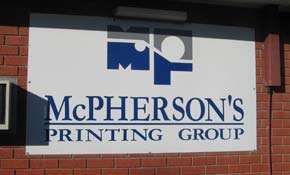
The proposed deal, for an undisclosed sum, will create an Asia-Pacific powerhouse, bringing together Opus’ Ligare businesses in Sydney and New Zealand with the McPherson’s Printing plants in Maryborough and Mulgrave, Victoria.
The combined entity, backed by private equity group Knox Investment Partners, will also have offshore production through wholly owned COS Printers in Singapore, as well as Opus’ strategic partnerships with book printers in Hong Kong, the US, Europe and the UK.
McPherson’s Printing will be demerged from its parent company, McPherson’s Limited, which will retain its larger, highly profitable consumer products division and remain listed as a separate entity.
Under the deal, which remains subject to regulatory and shareholder approval, the combined Opus-McPherson’s business will be listed as a separate entity on the ASX.
The read-for-pleasure printer will continue to trade as McPherson’s Printing, a name that first appeared when it was founded in the Victorian country town of Maryborough in 1946.
McPherson’s Limited will present the demerger proposal for shareholder approval in early December, and it will be decided at a general meeting in January. The Opus acqusition is being treated as separate to the demerger, and will be subject to shareholder approval at a meeting in March.
McPherson’s Printing chief executive Alan Fahy told ProPrint that while the deal “is not a fait accompli“, he was “excited about the opportunity for us, for Opus, for the industry and for our customers”.
The deal will satisfy two long-held desires at Opus: a public float and high-volume inkjet technology for its on-demand printing strategy.
Opus chief executive Cliff Brigstocke called it “a transformational event” for the group, which has grown from a turnover of $29m in 2007 to hit an anticipated $140m in sales when the merger completes.
The deal comes after years of downward trends at McPherson’s Printing. According to results posted on the ASX, its 2011 revenues were $58.9m, having fallen every year since 2007, when it turned over $73.3m, while printing margins have fallen from a high of nearly 7% in 2007 to 4.9% this year.
The two companies employ a combined workforce of up to 700 employees, though both Opus and McPhersons said it was too early to make any comment about jobs.
The job security of the 270 staff at McPherson’s Printing – many of them unionised and based in regional Victoria – become a central focus in the outcry over the 30-day rule negotiations in 2009.
The company will soon be the proud owner of one of the region’s top-spec digital presses, when it receives a black-and-white HP T400 inkjet web, due to be operational early next year.
The planned merger and the ‘Content Delivery Alliance’ of worldwide book printers is being driven by the increasingly global demands of book publishers, many of which are asking for a single supplier approach to printing. There is also consolidation activity taking place between the kinds of mainstream publishers serviced by McPherson’s and publishers of the education and professional work in which Opus specialises.
Brigstocke said: “We’re at a moment of exciting new technology and social change. The Opus Group must be the most valuable partner for our clients, providing content delivery and facilitating interaction with their consumers.”
Opus Group is a diversified business: along with its publishing operations, it owns signage printers Cactus Imaging in Australia and Omnigraphics in New Zealand, as well as public sector printers CanPrint and Union Offset in the nation’s capital.
Comment below to have your say on this story.
If you have a news story or tip-off, get in touch at editorial@sprinter.com.au.
Sign up to the Sprinter newsletter
